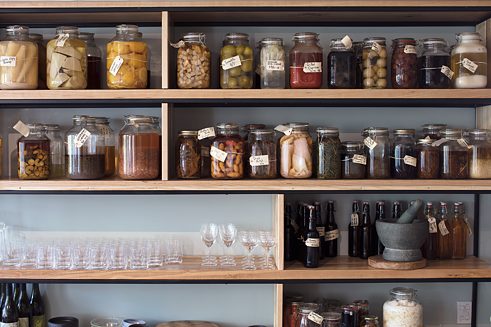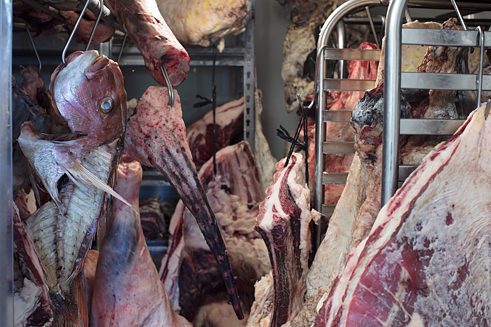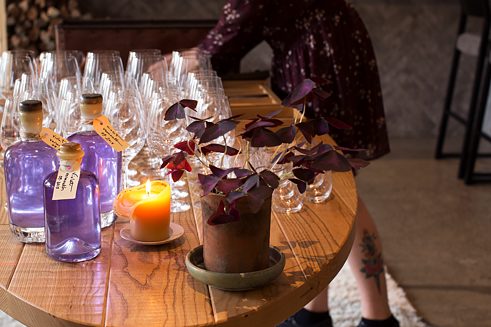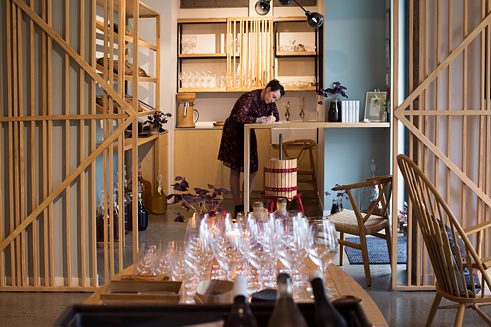Culinary Harbour Cities
PASTURE: A SEAT AT THE PASS
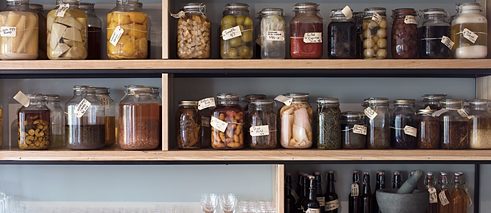
Pasture is focused around six seats at the pass directly in front of the red hot heart of the open fire where chef Ed Verner cooks with a fan, sparks flying, to prepare his carefully crafted menu with ingredients which are often a year in the making. It’s a theatrical yet intimate experience unlike any other fine dining establishment. On a trip to New Zealand in 2017 the late Jonathan Gold, heralded food critic for the LA Times, told a Stuff reporter that his standout food experience in New Zealand was his meal at Pasture.
The wall behind the bar resembles something of a beautifully curated specimen cabinet - jars of lactic parsnip, milk liqueur, salted cherries, pickled pine, grilled capsicum juice, oca root and even a muttonbird vinegar sit on the shelves. These ferments, brines and pickles reflect not only the creativity of the dishes that end up a part of the 12+, but also chef Ed Verner and his wife, co-owner Laura Verner’s approach to sustainability.
For this interview I spoke with co-owners and husband and wife team Ed and Laura Verner about sustainability, creativity and innovation.
How would you describe the philosophy at Pasture?
Ed Verner (EV): Use the best bloody ingredients we can find, which are perhaps unique or special to New Zealand and present them and cook them in the best way you can. I want to really focus on how to cook it perhaps surprisingly to how people would normally eat that and challenge them in different taste combinations, but always keep it simple. I’m always thinking how I can strip a dish back.
At the moment we have a Snapper dish on the menu and when we put it down it’s just a fillet of fish and then we pour the sauce table side. But it is the best damn piece of fish. I get a real kick out of serving a common fish like snapper to people and it is a revelation to them as they haven't eaten snapper like that before. That's what I am getting at - taking an absolutely beautiful piece of seafood and treating it in a way and cooking it with a real level of detail and presenting it simply. We cook it on the fire, really crisp up the skin and serve it rare so it just melts in your mouth. A lot of people will walk out of here saying that their favourite dish was the snapper.
Laura Verner (LV): People often leave and say that they feel like they’ve been in our home. I think it is because we are so completely transparent. This is why we wanted an open kitchen and why it is important for us that you have a high level of personal service. It's a curated journey through a season and ideas. The idea is to give them a genuine authentic experience that also challenges their ideas about flavour and food. I think that people appreciate it because it is just really honest and raw. People come with a lot of assumptions about what fine dining is and we like to try and break down those barriers as soon as they arrive.
Sustainability is something which I know is incredibly important to you at Pasture. I know that you buy your meat as whole beasts and butcher and age it yourself. It also seems to me just from looking at the walls and the jars that nothing is ever wasted. Why is this important to you?
EV: We get our lamb, pork and beef all as whole beasts. We’re on cow number 5 or 6. That’s 500 kg of cow at a time and there is barely enough room, but we have one fridge for our beef ageing. So firstly, I can control the quality and the butchering and I don’t have to rely on third parties. I can butcher according to Pasture’s needs and use everything. Half the time the only way you can get meat is vacuum sealed in plastic swimming in blood. I don't want to do that here. Second, the traceability in the meat industry isn't the same as in other industries. For me finding a farmer who produces amazing meat to supply the whole animal just means I can bypass the entire industry. Third, the way that you age your meat is on the bone. So we need for the meat to be on the bone covered in fat and finding meat on the bone is very difficult. It has taken years to find the right producers. I'm grateful for those producers that are happy to work with us. Normally a restaurant would get ingredients week by week which is easier to manage cash-flow wise. So here buying a whole cow - three months worth of meat in one hit - it’s challenging.
There are always jars of things around and buckets bubbling away: salted stuff, vinegars, all kinds of things. Sometimes you buy a load of great, prime seasonal stuff or we’ll use leftover waste products. For example the grapefruit skins on the shelf is leftover from juicing. Also if I have leftover produce from a dish that’s been on the menu then I'll save it and preserve it. It allows me for example to keep green strawberries on the menu even when they are out of season. At the moment we have a white asparagus on the menu and anything leftover that isn’t used we will juice and ferment and that means I have a store of white asparagus to use in the winter menu. There is a lot of planning ahead.
Our current beetroot dish uses cherry blossom preserves and beetroot two ways. We glaze the beetroot using preserves (plum, rhubarb, strawberry), it’s a very acidic biting dish. The red beetroots have been glazed with the berries so they are very chewy and then the chioggia beetroot are a little more crispy and pickled in the acidic preserves and then we have the salty cherry blossoms. So that’s a really interesting complex dish.
Pasture is known for its highly creative drinks menu where both cocktails and non-alcoholic drinks are paired with each dish throughout the tasting menu. Can you tell me a little about the drinks programme?
EV: Pasture is about being creative and so whatever vehicle I can find to be creative I will and push that obsessively to the best quality I can.
We make up our drinks often using things that perhaps your average barman wouldn’t use - vinegars, salted brines and ferments. Some of the cocktails are quite challenging and some you wouldn’t want to drink them on your own perhaps. They’re designed specifically to match to the dish.
On the beetroot dish we have cocktail called Mr Roboto, which is made using a mirin that we make here and that’s mixed with cherry blossom and fermented rhubarb. It’s very salty, sour and sparkling. The non-alcoholic drinks are pretty fun, it’s a bit of a roller coaster. For example we currently serve a pressed new season strawberry juice infused with toasted buckwheat which matches the white asparagus. We do a sourdough “beer” with a pig crumpet, which is a crumpet off the fire with house-cured pancetta from heritage black pigs. This charcuterie was made about a year ago. Other non alcoholics include fermented cucumber, almond milk and another naturally sparkling infusion of New Zealand grown oolong.
The format at Pasture is completely unlike any restaurant I’ve ever been to with the six seats at the pass overlooking the chef. Tell me why you made the change from the usual table service to a set tasting menu at the pass?
EV: We started as a 20 seat restaurant and now we’ve moved to two seatings at the pass of six and six. I’ve never loved Pasture more. Preparing the food we do means really long hours and finding the right chefs was hard, courses flying out at all different times is stressful and also the people that seemed to get us the most were the people sitting at the pass and not the people in the tables in the corner. It feels very liberating to do what we’ve done and to know we can change it up next year if we want to. It’s always going to be fun and interesting.
LV: People become really connected to the pace of the fire and Ed cooks with a fan on the fire. It is not a kitchen based around pots and pans. The fire is the glowing heart of the restaurant and not many people can be immune to the lure of the fire.
We’re happy being the punks of the scene and subverting what’s normal. I have a real strong sense of advocacy and if you do something it should have purpose and I think there is a real sense of that here at Pasture. We want Pasture to be innovators in the industry, which often doesn’t come with the success and accolades, but that's not what why we do it.

